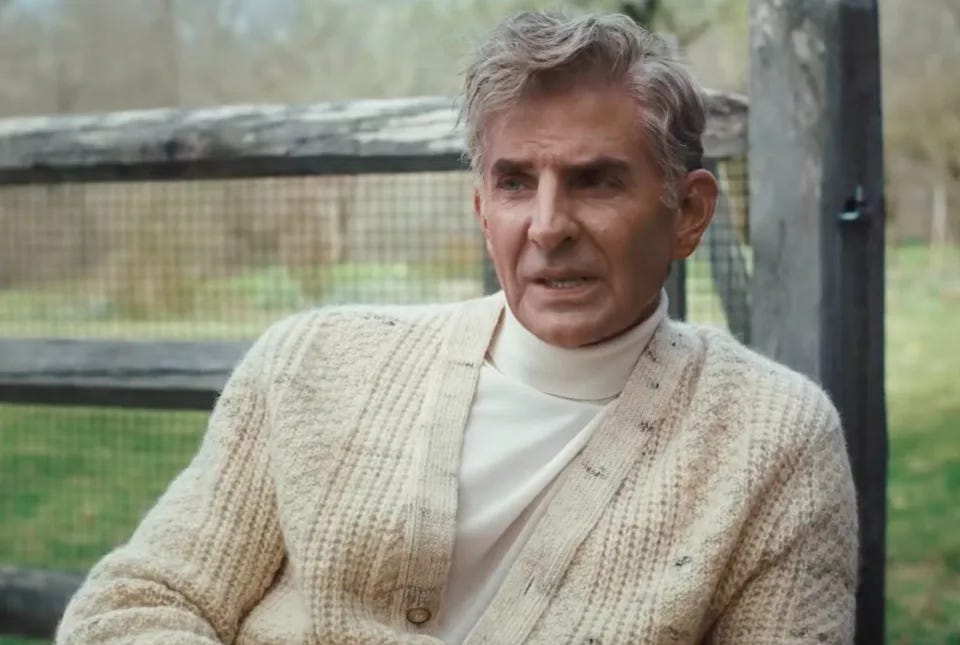MAESTRO: Leonard Bernstein dressed the way he conducted — daringly
MAESTRO's turtlenecks, TÁR's tailoring, and conductor style.
Has anyone loved turtlenecks as much as Leonard Bernstein loved turtlenecks?
The great conductor/composer/classical-music-deity wore plain cotton turtlenecks and thick ribbed ones. Black, cream, brown, burgundy. He wore them under denim work shirts and suit jackets. He frequently wore them on their own, too.
Bernstein looked extraordinarily good in turtlenecks. Actually, he looked good in everything. And I do mean everything. He lent the most over-the-top fur-topped coat stately gravitas — and also, like Joe Namath or Warren Beatty in McCabe & Mrs. Miller, pure masculine swagger. He imbued the most staid suit with flamboyant flair.
He loved silk cravats and striped pullovers and jaunty scarves and plaid pants. But also: sneakers, loafers, jeans. He had style. This was a man who conducted the New York Phil with a cigarette holder, with lit cigarette, between his teeth, without missing a beat (or — miracle of miracles — launching into a coughing fit).
Maestro — the new movie about Bernstein, directed by and starring Bradley Cooper — features its fair share of turtlenecks. In one scene, Cooper wears a white turtleneck over a chunky cream-colored V-neck cardigan. In another, he dons a wine-colored knit one under a double-breasted wool plaid jacket. As Bernstein/Cooper grows older, his ensembles get flashier — or maybe just more openly, confrontationally gay. (Bernstein was bisexual.) He starts the film out in broad-shouldered suits; he ends in a white linen ensemble, shirt unbuttoned an almost scandalous amount for an elder man, a long necklace with large pendant against his bare chest. He’s too tan. He’s paunchy. He’s a widow. He’s maybe a bit desperate. But he’s still got that resplendent head of wavy hair. He’s still glorious.
Maestro got me thinking about Bernstein’s presence, and how his sweaty, ecstatic conducting style spilled over into every aspect of his life and his self-presentation, including his dress. That outward expression of style is not something you usually see among classical musicians of any sort, least of all conductors. (And believe me, I know, I am a classical violist.)
Of course, Bernstein happened to live in a time when fashion — men’s fashion in particular — was more fabulous. The movie opens in the 1940s, with broad-shouldered snazzy suits and extends through the more expressionistic ‘60s and ‘70s: flared jeans, big sunglasses, and of course turtlenecks. Turtlenecks were the perfect uniform for Bernstein: comfortable, easy to move in, a perfect way to show off his thick hair. But they also were modern: asexual, countercultural, revolutionary, worn by beatniks and Black Panthers. They signaled a more relaxed attitude in all aspects of life and self-expression. And Bernstein flouted and upended all sorts of conventions, not least of which included dragging classical music into the contemporary pop world.
“[T]he conductor is part servant, part leader and, most of the time, just trying to stay out the way,” wrote conductor/soprano Barbara Hannigan in a 2015 oped for The Guardian. When she first started conducting, in her 40s, she thought she had to banish the bias-cut gowns she wore as a singer. “I thought trousers and jacket were the ‘costume’ I had to put on,” she wrote. Then, she was asked to conduct and sing William Walton’s sassy song cycle “Façade.” A suit would not do. She picked something “appropriate to the theatricality of the piece — a strapless evening gown.”
“A friend commented on the expressivity of my arms, and it struck me that this was part of my strength as a conductor,” she wrote. “… [T]o cover my arms in a jacket might serve convention, but not the music — and I never wear suits in real life!”
Hannigan believes that the best way to serve the music, as a conductor, is to match its attitude, its spirit, through dress — not to appear invisible. Bernstein goes one step further: he is not serving the music, he is the music. And he never stops being the music, even when he is offstage (which he kind of never was … Bernstein was always performing, always on). He dressed with the same expressiveness and enthusiasm with which he conducted.
I should add here that Maestro is not really about Bernstein the Conductor, but about Bernstein’s and wife Felicia Montealegre’s complicated, mysterious, and yet enduring marriage. (They had a somewhat open arrangement, where Montealegre — elegantly played here by Carrey Mulligan — tolerated her husband’s affairs, as long as he remained discreet, which he often wasn’t, but she inevitably eventually always forgave him.) Cooper, as director, seems to be saying the Montealegre’s support, her patience, allowed Bernstein to flourish and be Bernstein without self-destructing. Maybe … but …
The movie didn’t really click for — besides the wonderful production design, including the costumes — was when Bernstein conducts Mahler’s gargantuan Second Symphony, in a cathedral in London. Much has been made about how Cooper studied conducting this piece for years just so he could execute this six-minute snippet of music. But it was worth it. (He’s actually pretty good!) Here, you see Bernstein not conducting but embodying the music, in all its exalted, messy glory. Suddenly I understood Maestro’s striving, almost desperate directorial style, and how it offered a window in Bernstein the person and what drove him.
After all, Bernstein went so hard, with such gusto and glamour and recklessness, not just in creating and conducting music but in living. Once you experience the transcendent highs of becoming Mahler’s Second (or any great piece of music) wouldn’t you try to chase that in every facet of your life, forever and ever? No matter how many people you hurt or annoy or betray or offend? And wouldn’t it also make everyone forgive you and love you despite all your monstrous selfishness?
Maestro offers a sunnier, more magnanimous view of the power of music than last year’s Tár, starring Cate Blanchett as a fictional conductor embroiled in a sexual-abuse scandal. Like her hero Bernstein (with whom she claims she studied), Lydia Tár conducts with flamboyant flourish, and lives life with glamorous swagger, aided by her exquisite tailor-made trousers and shirts, her silk cravats and turtlenecks, her expertly tussled blonde hair. Tár shows a lot more music-making than Maestro — you see Blanchett rehearsing, discussing music in minute detail, wrestling over a composition. You also see the inner-workings of the cut-throat classical music world, with all its backstabbing and backbiting and bad behavior. But Tár is a movie about power. Maestro is a movie about love.
Funnily enough, Tár’s climax also involves a Mahler symphony — his virtuosic fifth. But for Tár, Mahler is a summit to climb, a monster to conquer. For Bernstein, it’s a joy. Bernstein had his demons, his struggles. But it is his joy, his electricity, his hope, his beauty that remains, that he gave to the world. Maestro’s costumes do a beautiful job in conveying just that.








Great article, thank you!